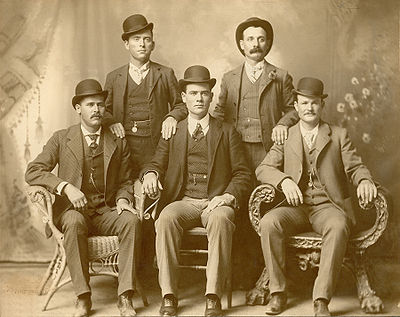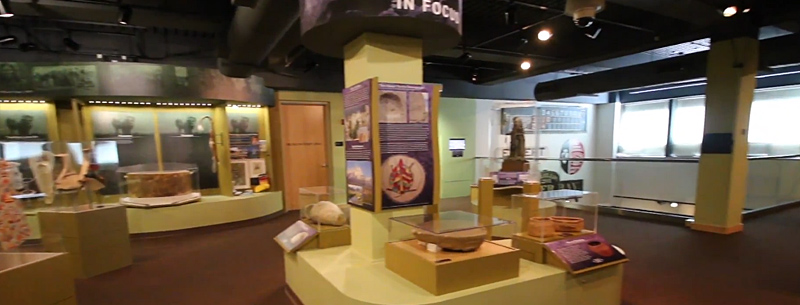The Wyoming State Museum is a fabulous free spot in Cheyenne to learn more about the state of Wyoming. We admire Native American art, learn all the ways they used a buffalo, explored an exhibit about the Wyoming State Capitol, and much more. It’s known as a “one-of-a-kind”, the only one like it in the world. And once inside, there’s no doubt as just how true that is. The historic Barrett Building, just south of the State Capitol in Cheyenne, is the perfect home for the Wyoming State Museum, where the entire history of Wyoming is on display.
And I mean the complete and entire history of this great state. The Museum is more like an open, life-sized storybook. There’s gallery after gallery with displays and artifacts that take you all the way back to the dinosaur age. And every momentous era and event from that point on.
The Wild Bunch Gallery is a popular destination at the Wyoming State Museum, and there’s the always well—attended Hands-on History wing. That’s where viewers are allowed to literally touch and handle the artifacts.
This really is a truly unique walk through history. And if you’ve ever wondered what things were really like way back when, right here where we live, this is your place.
the Wild Bunch
These guys were famous, kind of like the “rockstars” of their day. They weren’t a band of musicians, however. Oh no, they were a band of marauders that had gained their frontier fame by robbing banks and trains. Long before Bonnie and Clyde, and John Dillinger, there was The Wild Bunch.
The Wild Bunch was a gang that pulled jobs all over the wild west but would hang their hats, and count their loot, right here in Wyoming. Their hideout was located at another site that has been recognized as a Wonder of Wyoming itself, the Hole in the Wall, located in the southern Bighorn Mountains, just west of Kaycee, Wyoming. The locals actually called the Wild Bunch “The Hole in the Wall Gang”. And from 1896 to 1901, a short but very active span, the Wild Bunch made their name and their criminal fortunes.
The gang itself was made-up of a handful of cowboy desperados, but it was a duo of experienced outlaws that would lead the group. Their names — Robert Parker and Harry Longabaugh. Oh, they would soon become famous under their established pseudonyms, Butch Cassidy and the Sundance Kid. Butch was the brains, Sundance was the fast gun. The other members of the Wild Bunch were characters like Kid Curry and Walter “the Watcher” Pulteney. William Ellsworth was in the gang, he was better known as Elza Lay.

Ol’ Butch was already a well-known citizen of the young state out West. Cassidy took that name from a childhood mentor and partner in crime, Mike Cassidy. “Butch” had stuck as a first name after working a few years in Rock Springs, Wyoming, as, of course, a butcher. Robert Parker had become Butch Cassidy. Harry Longabaugh, the Sundance Kid, was just a teenager when he joined-up with Butch Cassidy. He took his moniker after serving time in the Sundance, Wyoming, jail for horse-thievery. The Wild Bunch would change its cast of characters, but Butch and Sundance were the mainstays and the true ringleaders.
Butch Cassidy had actually served a little stint himself in the old Wyoming Territorial Prison in Laramie. Caught rustling horses, Butch spent 18 months behind bars but was pardoned by the Governor on the promise that he would never carry out any similar activities in Wyoming. Butch and the Wild Bunch would break that promise a few years later.
Before the Wild Bunch started robbing trains in Wyoming, Butch Cassidy and the gang had taken on a sort of “Robin Hood” aura in the area around Hole in the Wall. They were outlaws, but they were the outlaws that were stealing from the rich railroads and banks, the wealthy cattle barons, and mines. And when they were at their home, their hideout, they spent their money locally. And the Wild Bunch didn’t rob and steal locally.
But eventually, on June 2nd, 1899, the Wild Bunch did pull-off a local job. The gang robbed a train near Wilcox, Wyoming, and made-off with astounding 50,000 dollars. The daring feat included the use of dynamite to blow up the safe, and it would send Yankee greenbacks flying in all directions. But the cash was quickly gathered, and the Wild Bunch had executed what would come to be known as “The Great Train Robbery”. In 1900, the Wild Bunch struck again. This time they hit another Union Pacific train near Tipton, Wyoming, just east of Rock Springs. The “take” was a meager 54 dollars. The train with 100,000 dollars aboard had passed through a few hours before. The Wild Bunch got away again, but it would be the last time the gang would be seen in Wyoming.
The Wild Bunch was off to other venues to apply their trade. They would rob banks and trains in Montana and Nevada. Butch Cassidy and the Sundance Kid would eventually re-locate to South America, and accompanied by Etta Place, the two would rob a number of banks in Argentina and Bolivia. Although there is still some speculation as to how and when Butch and Sundance met their demise, the most compelling account has the two former Wyoming outlaws dying in a blaze of gunfire on the Bolivian-Argentine border.
The celebrity and legend of the Wild Bunch was certainly front-page stuff in young Wyoming. They were, quite simply, the most famous outlaws in the land. That legend perpetuated itself into an Oscar-winning movie, “Butch Cassidy and the Sundance Kid”. Long before that, the silent movie classic, “The Great Train Robbery”, telling the story of the Tipton train robbery in 1899, was a big Hollywood hit.
Oh yeah, these guys were famous for all the wrong reasons. But Butch Cassidy, the Sundance Kid, and the Wild Bunch were Wild West Wyoming “stars” nonetheless.
